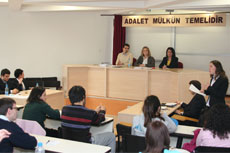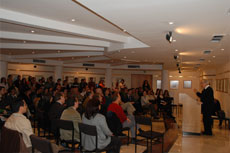First Gene Implicated in
"Quadrupedal Gait" in Humans Identified


A team of scientists in Bilkent University's "Department of Molecular Biology and
Genetics" have identified the first gene implicated in the upright walking of humans.
The study, which was published on-line in the "Proceedings of the National Academy of
Sciences" (PNAS), USA, reports that the gene encoding the very low density
lipoprotein receptor (VLDLR) has undergone mutation in two families in which multiple
relatives walk by quadrupedal gait. (continues)
Bilkent Moot Court Team in Vienna


The Faculty of Law Moot Court Team, made up of fourth year
law students Pınar Çağlayan, Mustafa Durakoğlu, Utku Kerem Kırklar and Öncü Serter,
will participate in the "15th Willem C. Vis International Commercial Arbitration
Moot" in Vienna, March 14 to 20.
This annual competition aims to promote study in the areas of international commercial law
and arbitration, and encourage the resolution of business disputes through arbitration.
Moot participants will face a case based on an international sales transaction under the
United Nations Convention on Contracts for the International Sale of Goods, 1980 (the
CISG). The moot will consist of two stages: the submission of a written memoranda for the
Claimant and the Respondent, and a hearing of oral arguments based on the memoranda.
Library Lunchtime Lecture Series Begin with Prof.
Halman


Prof. Talat Halman, Dean of Humanities and Letters at
Bilkent University, opened this semester's Library Lunchtime Lecture series on March 6,
with an entertaining presentation entitled "Shakespeare the Turk". Prof.
Halman's talk was based on his book
"Türk" Shakespeare: Shakespeare'in Dünyasında Kahramanlar ve Soytarılar
(Ankara: Hece Yayınları, 2003) and was a performance of classic and comic
interpretations of Shakespeare's work from Turkey, England and elsewhere in the world.
Following the talk, Prof. Halman answered questions from the audience. The lecture took
place in the Main Campus Library Art Gallery, and the audience was supplied with
refreshments. The Bilkent University Library is extremely grateful to Prof. Halman for
agreeing to open this lecture series. The Library Lunchtime Lectures will continue on
March 27 with a lecture on evolution and human diseases by Prof. H. Tayfun Özçelik
(MBG).


Bilkent News Interactive is
best viewed by 800x600 resolution.
You can send comments, questions, etc. about Bilkent News Interactive by clicking this
link.
|
CDPC Career Fair: A Chance to Determine
Your Future

The Career and Development Placement Center (CDPC) is holding a
Career Fair, Thursday, March 13. This is a great opportunity for students to meet with
representatives from about 44 different companies and find out about their recruitment
policies.
This will be an annual career fair, designed to supplement the seminars and workshops put
together by the CDPC. The event takes place between 10 a.m. and 5
p.m. in the Main Sports Hall. Find out what your future may have in store with
you. Will it be a job with a major firm? Will it be a life changing internship? The
possibilities are endless. Explore them at the CDPC Career Fair!
New Books Published by
Bilkent Archaeology and History of Art Faculty


Several new books have been published by members of the Archaeology and History of Art
Department (HART), reflecting the wide range of research interests covered by its
multinational faculty.
Dr. Thomas Zimmermann, Assistant Professor and Acting Chair of the department, authored
two books, focusing on entirely different topics: "The Bronze- and Iron Age: Finds
from the Heinrich Schliemann Collection, Römisch-Germanisches Zentralmuseum Mainz,"
(Die bronze- und früheisenzeitlichen Troiafunde der Sammlung Heinrich Schliemann im
Besitz des Römisch-Germanischen Zentralmuseums). Issued by the Römisch-Germanische
Zentralmuseum in cooperation with Schnell & Steiner publishers, reappraises
archaeological finds from the famous site of Troy in Northwest Anatolia, originally
excavated by Heinrich Schliemann in the late 19th century. Importance is given to the
scientific value of "antiquarian" museum collections that can still deliver
surprising results for the modern researcher. (continues)

Also in this issue:

|







